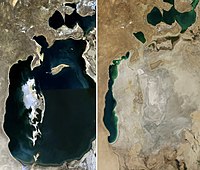
Photo from wikipedia
The global challenge of understanding and forecasting ecosystem responses to climate extremes and climate change is addressed in this review of research enabled through environmental research infrastructure (RI) provided by… Click to show full abstract
The global challenge of understanding and forecasting ecosystem responses to climate extremes and climate change is addressed in this review of research enabled through environmental research infrastructure (RI) provided by Australia's Terrestrial Ecosystem Research Network (TERN). Two primary climatic drivers of ecosystem structure and function in Australia are fire and aridity, to which Australian flora and fauna have shown marked adaptability. Australian vegetation shows resilience to climate extremes of flooding rains, droughts and heatwaves such that variability in primary productivity of Australian vegetation has a tangible effect on the global carbon cycle. Nonetheless, Australian flora and ecosystems could be vulnerable to projected climate change (e.g. to increasing vapour pressure deficit). Refugia are also vulnerable to climate change, with conditions in these areas already near the tipping point for a change in community composition. Ensuring genetic diversity during directional change in climate (e.g. increasing aridity) requires proactive approaches to conservation and restoration projects. To address these challenges, TERN provides environmental RI at three scales of observation: (i) environmental monitoring using remote sensing techniques at a landscape and continental scale; (ii) a spatially extensive network of ecosystem monitoring plots; and (iii) intensely measured sites collecting detailed data on ecosystem processes. Through partnerships with international environmental RIs, TERN enables research that addresses global challenges, on the first steps toward the forecasting of ecosystem-climate interactions.
Journal Title: Environmental Research Letters
Year Published: 2019
Link to full text (if available)
Share on Social Media: Sign Up to like & get
recommendations!